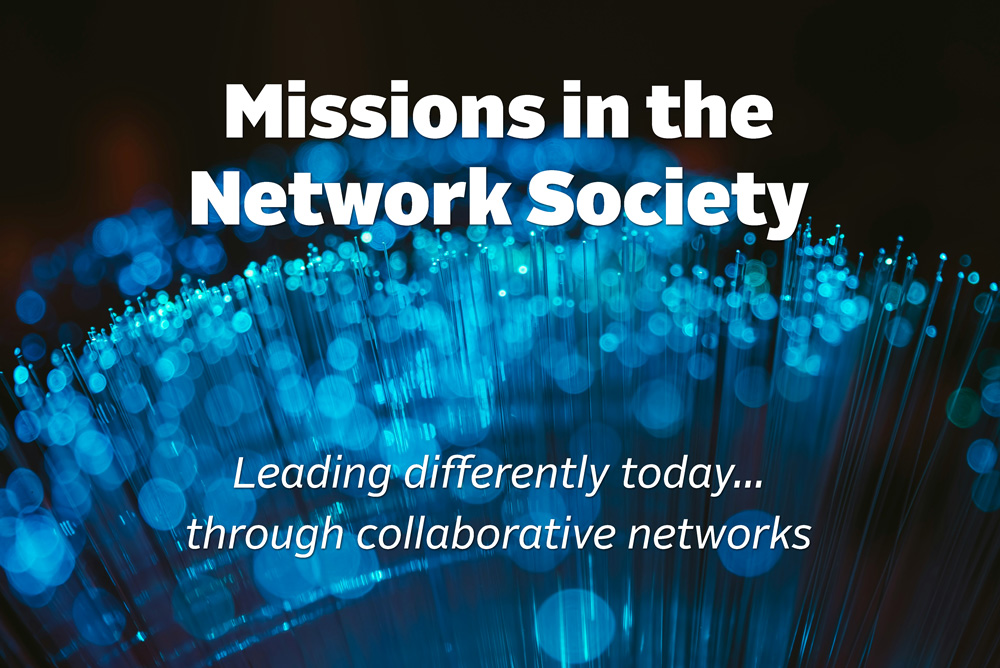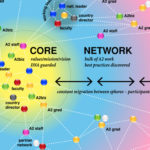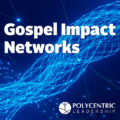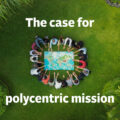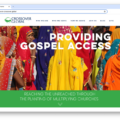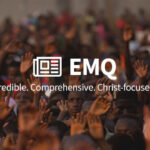EMQ » January–April 2024 » Volume 60 Issue 1
https://missionexus.org/missions-in-the-network-society/
Summary: The world is more interconnected than ever before, and the way we do missions is being redefined as a result. Individuals are connecting in collaborative networks which is impacting the way we lead. This, in turn, is changing the role of Western mission sending agencies. What does this mean for the future of missions?
BY ELDON PORTER AND JOSEPH HANDLEY

Jack Welch, the former CEO of General Electric is famously quoted as saying, “When the rate of change inside your organization is less than the rate of change outside your organization, the end is in sight.” Over the last two decades, we have witnessed unprecedented changes. Sociologists say we have moved from the post-industrial age to what is now referred to as the “network society.” The Spanish sociologist, Manuel Castells, predicted this new reality in his book, The Rise of the Network Society.[1]
For Evangelicals, our reality within the network society is further nuanced by three factors. The first is that today there is a church in every single country of the world. Christ said he would build his church, and he is doing that. The second factor is technology. Not only can we hear from the church in every country, but believers in different parts of the world can connect virtually with other believers all over the world.
And the third factor is what the United Nations refers to as the Migrant Diaspora – approximately 281 million people have moved or are in the process of moving from their historical context of origin.[2] The combination of these factors is redefining how missions or cross-cultural ministry happens.
Individuals from around the world are now connecting in constantly emerging collaborative spaces that we refer to as networks. Influence is happening differently – it is not centralized. This is redefining leadership. And these, as well as other factors in today’s polycentric and networked world, leave traditional Western mission sending agencies with a choice to either significantly change or risk obsolescence.
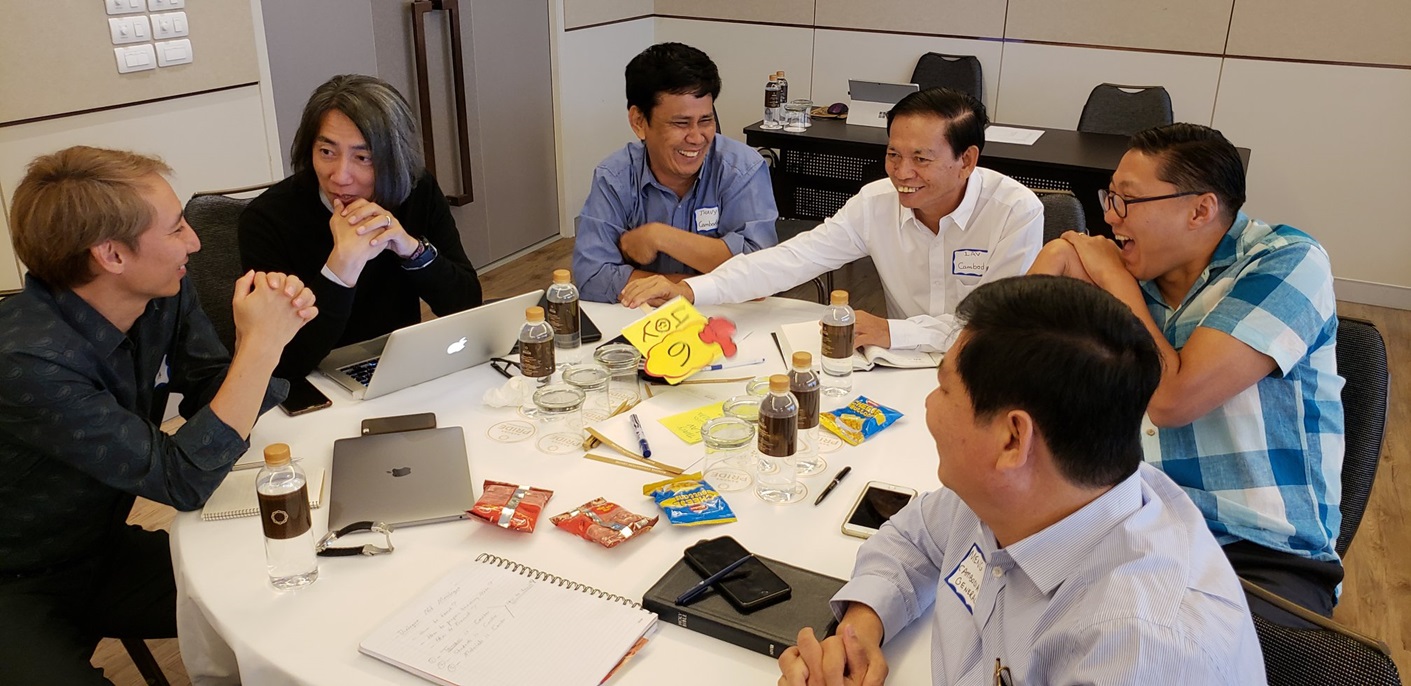
The Proliferation of Collaborative Networks
Our new reality allows for believers from around the world to connect, learn from, process challenges, and then find ways to collaborate. These collaborative networks are not organizations. Instead, they are constantly evolving networks that reflect the unity of the global body of Christ.
A network is a space where autonomous entities come together around a shared passion or challenge. A well-run network constantly births partnerships – intentional points of collaboration between known entities that commit to work together to accomplish something not one of them could accomplish on their own.
Hundreds of networks based on geography or issues emerge constantly. When Christ followers from different cultures come together in these networks, practitioner sourced expertise emerges. Challenges can be addressed in dynamic dialogue among diverse groups across different fields of expertise.
Many challenges require multi-network collaboration creating collaborative ecosystems for ministry practitioners. For example, there are at least 13 unique networks, representing numerous practitioners and organizations, that intersect in some way around the Ukraine crisis.
No one network can provide leadership for all the distinct challenges associated with this or any situation. In a collaborative ecosystem, each network learns about the unique contributions of the other networks, what their constituents are able to offer, and where collaboration can be encouraged to take place around particular challenges.
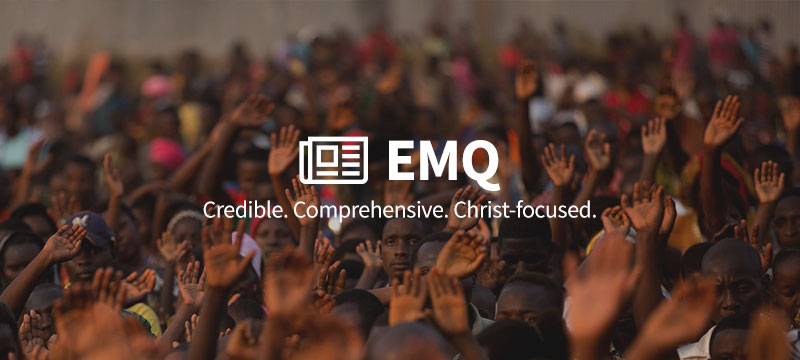
Leading Differently
The foundational principle for any Christian seeking to lead other Christians has not changed. As children of God, we are all followers of Christ. He is the head of the church, and we seek to walk in obedience to him. The top priority of any Christian leader should be to help those they seek to lead to understand how Christ is working and how they can follow him most effectively.
Yet our world today has become unimaginably complex. The fact that there is a church in every country of the world, that there is technology that facilitates global connections, and that we are witnessing the largest diaspora movement ever recorded in human history is revealing sources of expertise and new ideas that we have not seen before.
Perhaps the most significant implication for us is that we can now hear the voices of Christ followers from every country of the world. They are the ones who know how Christ is working in their context and how he is working in and through them in the face of their challenges.
This changing context requires that leaders lead differently. In the past, those in official leadership roles were often the primary source of information and guidance. Today, leadership occurs more through influence than title. And it happens through multiple channels.
People can find great information and make outstanding connections from anywhere in the world. Leaders in this context don’t seek to have all the answers. They lead best when they provide information and connections that help those in their sphere of influence be more effective in whatever they are seeking to do.
In a polycentric world, networks have become the place where practitioners can connect with anyone anywhere interested or involved in a particular area of focus. For example, to learn about what God is doing in Central Asia, connect to a network with this focus, and you will meet believers from the region and from around the world who are focused on that area.
To connect with others who feel called to minister in India, the gathering of the India Missions Association provides opportunities to meet leaders from the Indian churches and mission organizations that are already engaged with the unreached in India.
Those with a passion for serving refugees are connecting into the various parts of the Refugee Highway Partnership network to learn from others and discover ways to collaborate around particular people groups that are now scattered around the world. There are over 750 collaborative networks globally that provide spaces for believers from around the world to be able to connect with each other around shared passions.
Organizations that embrace this new reality can intentionally channel their staff into various networks or even catalyze or facilitate networks. As a result, they see partnerships with others develop that enable them to accomplish together what they could not accomplish on their own. This creates an attractive environment where individuals, ministries, and organizations serve one another and can more organically respond to God’s call.
And networks are also intentionally connecting with other networks to create collaborative ecosystems for their constituents around particular challenges. One example of a network leadership hub is A3 (formerly called Asian Access). They bring leaders together from across different networks and denominations to learn from one another in collaborative learning communities.
These collabs meet quarterly for anywhere from an extended weekend to a 4-day week in retreat-like settings. As the participants get to know each other and build relationships and trust, they often forge powerful collectives addressing church multiplication or systemic issues their communities and nations face to improve society.[3] Ultimately, the hope is to see collaborative communities fostering innovation, sparking deeper personal growth, and uniting the body of Christ in their countries.
A3’s leadership ecosystem also follows a network structure. This polycentric model empowers each country to lead in ways that work best in their cultural context. The primary thing holding these loose networks together is a shared sense of vision, values, and mission. The model flows from a missiological principle developed by Paul Hiebert about centered sets.[4] Most everything else is decentralized allowing each local entity to foster connections and collaboration as best fits their local situation.[5]
![]()
Core Themes of Polycentric Leadership
In researching this, and other similar models, I (Joe) discerned six core themes (or traits) that are indicative of this type of network or polycentric leadership system.[6] Leaders practicing these six themes are better able to foster environments where people grow, develop, and flourish.
Polycentric leaders are built on a charismatic foundation. This theme shows its greatest strength in the spirituality of the leaders and the depth of their walk with Christ. This reliance on Jesus at the core is what inspires others. And it displays itself most readily in the character of a leader. People follow leaders they trust and are reliable. When leaders display integrity in their approach to ministry, trust is built that strengthens the commitment to engage.
They are also relational in their approach to ministry. Friendship and bonding become the lifeblood of who they are, and in that environment, community (a third theme) is formed. In this communal setting, commitment to one another and to common cause or mission is emboldened. As they walk with one another, hold each other accountable both personally and across their networks, they become a tight knit band of leaders willing to tackle significant giants in mission.
This ecosystem lends itself to collaboration (a fourth theme). As leaders spend time together, play together, learn together, and grow, they discover common vision and are inspired to do things together that they could never envision when alone. This common vision coalesces in a collaborative community inspired by God to serve him in what can be powerful social enterprises.
Speaking of enterprises, entrepreneurship (fifth theme) is released in these ecosystems as well. Since the collaboration is voluntary and not controlled from outside or from the top down, there is freedom to pursue dreams that are shared together. Thus, a bottom up or collective leadership is energized to fulfill a local vision inspired by the Lord in their countries.
Finally, this leadership model is strengthened by diversity. When the ideas being reviewed and shared together come from across a wide variety of sectors, individuals, cultures, and denominations, they both unite the body of Christ and weave together the best ideas from a variety of backgrounds and settings. The ideas are refined through the lens of multiple layers of thinking ensuring that the best of the collective can be tapped for the mission of God in each region.
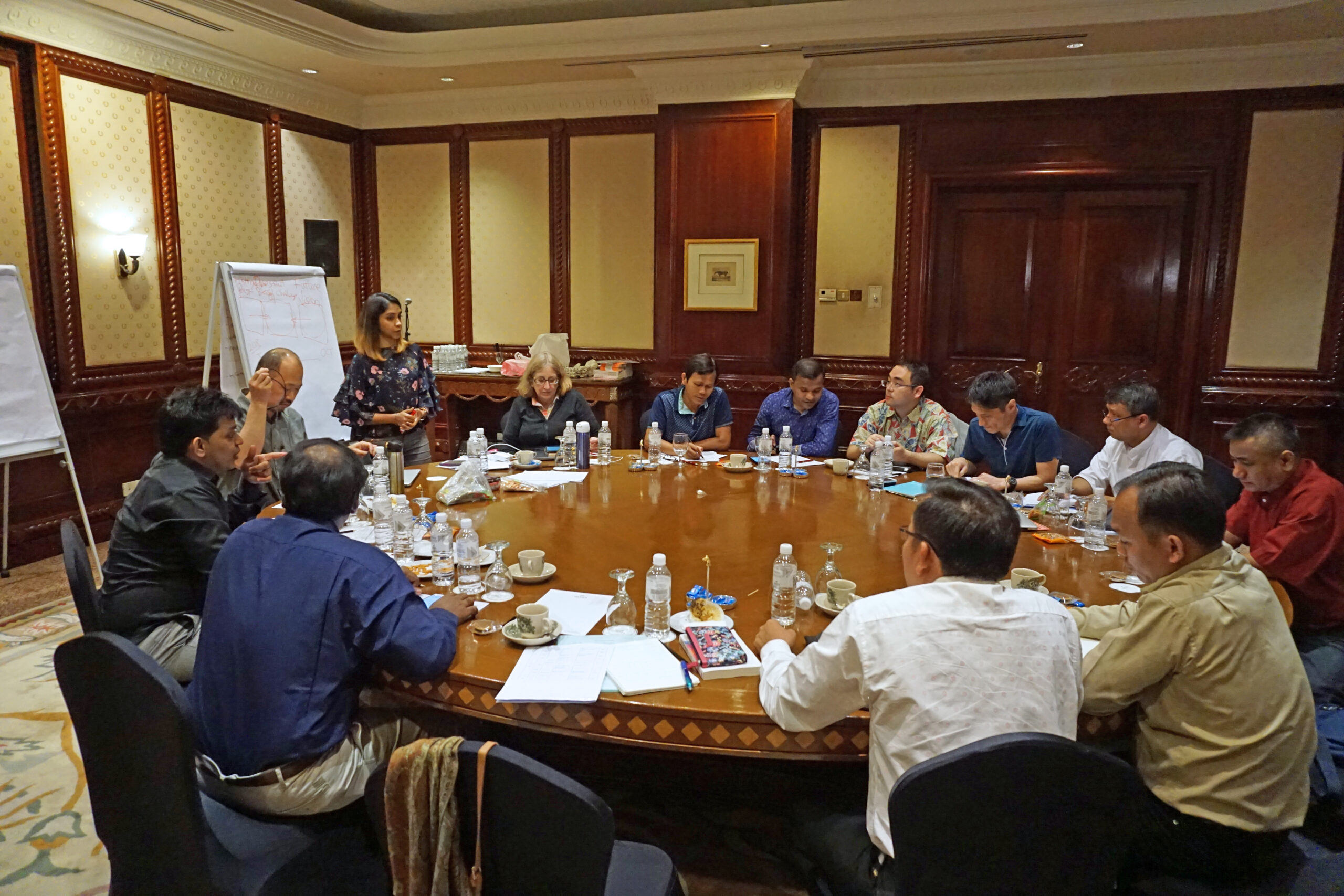
The Challenge for Traditional Western Sending Agencies
The Western model of missions has traditionally been built around sending workers to other parts of the world. Since the local church could not manage the various services associated with sending missionaries, mission agencies were developed to assist them in doing that. And it was through this process of sending out missionaries that individuals joined a particular agency that generally worked independently of other organizations. Western mission agencies are designed to send out their missionaries to do their agendas.
But our new global reality is redefining the value an agency brings to the church. The services associated with sending missionaries are now available in multiple and often more economic formats. The greatest need that churches now have has moved from sending workers to helping churches engage well in ministry contexts. How workers are sent, from anywhere in the world, is no longer the main challenge.
The most attractive agencies, today, intentionally receive qualified workers from anywhere in the world and connect them with other parts of the body of Christ in the context of effective ministry. The ability to connect well with the challenge or cause has replaced the value of becoming a member of a particular agency.
One of the newest kinds of networks we see developing today are those that are focused on people groups that are globally dispersed. We find these around the Uigyar, Rohingya, Pashtunes, etc. These networks gather information as to the different ministries and churches that are reaching out to the diaspora of the particular people group. They have contact details of churches and ministries in the different countries as well as a listing of resources that different ministries have developed.
They facilitate discussions between believers from around the world around particular challenges associated with the particular people group. These networks also seek to empower those that God is using to reach a particular people group by helping them to function in greater unity on a global scale. Mission agencies that serve the members of the local church well are either developing and managing these networks or engage well with those networks that already exist, so that they can best serve the local church’s effort in cross-cultural ministry.
The transition from being an agency that sends out workers to one that receives workers well into what God is already doing globally is not an easy task. Most Western mission agency leaders are connected in some way to the sending structures which are sustained by a tax (or assessment fee) on the support raised by the missionaries they send.
This tax provides for salaries for those serving in the offices as well as for the expenses associated with their leadership roles. This has led to extremely high support requirements required to sustain a structure that no longer has the value that it once had. While some agencies have downsized their sending structures others have not.
Leading change is difficult, and this is particularly so in this situation since those with the authority to make the changes are those that would be most negatively impacted by the changes. But local churches, around the world, are looking for help to get their members connected around particular challenges and issues. Some of this is being provided by networks, but mission agencies are also beginning to play a significant role in this effort.
One example of this type of transition is the partnership forged by A3. Years ago, realizing they lacked the capacity to fulfill their vision as a sending agency, they formed what became an award-winning partnership focused on Japan. SIM became the sending organization to leverage an economy of scale and A3 became the receiving mission for missionaries eager to serve in Japan. The partnership extends well beyond two organizations though. Networks of churches across Japan are involved, and missionaries serve under local Japanese leadership.[7]
Conclusion
Our world is changing. This is having a significant impact on global missions, but what has not changed is that Christ continues building his church. We are privileged to be witnesses to some of that. And our new global reality is allowing for the different parts of the body of Christ to be able to connect with each other, explore together what Christ is doing, and commit to work in unity in collaborative ventures around difficult and complex issues.
As leaders look to best leverage their time, treasure, and talents for God’s kingdom in this VUCA world, tapping the wisdom from network and polycentric forms of leadership can better foster innovation, collaboration, and mission effectiveness. More importantly though, is the theological truth of our Lord seeking unity for the body of Christ: “that they might be one [so that] the world may know…” (John 17:21–23).
_____________________________________
Eldon Porter (eporter@linkingglobalvoices.com) grew up in Africa, served in Bolivia for 21 years, and then was a vice president for SIM International. For the last 13 years, he has researched networks and global collaboration while mentoring both organizational and network leaders on creating collaborative ecosystems. He tracks over 750 Evangelical networks around the world through Linking Global Voices (linkingglobalvoices.com) website and database.
Joseph W. Handley, Jr., PhD, (jhandley@A3.email) is the president and CEO of A3 (a3leaders.org) and an ordained minister. He also serves as a global catalyst for leadership with the Lausanne Movement and as affiliated faculty of mission and theology at Fuller Theological Seminary. Previously, he was the founding director of Azusa Pacific University’s office of world mission and lead mission pastor at Rolling Hills Covenant Church.
More Information
EMQ, Volume 60, Issue 1. January–April 2024. Copyright © 2024 by Missio Nexus. All rights reserved. Not to be reproduced or copied in any form without written permission from Missio Nexus. Email: EMQ@MissioNexus.org.
This article was reposted with permission from EMQ and was originally published here: https://missionexus.org/missions-in-the-network-society/
Photo credit:
- Cover photo by Sander Weeteling on Unsplash
- A3 Faculty Training Breakout: Leaders from Mongolia and Cambodia brainstorm ways to develop training staff inside their countries who can equip emerging leaders. Photo courtesy of A3/Noel Becchetti.
- Multinational Cohort Grows & Learns Together: A3 Leaders from 5 countries across Asia from a two-year cohort to grow and learn from one another. Photo courtesy of A3/Jeff Johnston.
End Notes:
[1] Manuel Castells, The Rise of the Network Society (Blackwell Publishing, 2010).
[2] “Leveraging the Migrant Diaspora – SDG Media Zone at the 78th Session of the UN General Assembly,” September 18, 2023, https://media.un.org/en/asset/k1f/k1fdqhptoo.
[3] For examples of empowered voices see Noel Becchetti, Eastern Voices Volume 1: Insight, Perspective and Vision from Kingdom Leaders in Asia in their Own Words (Asian Access, 2017).
[4] Paul G. Hiebert, “Conversion, Culture and Cognitive Categories,” Gospel in Context 1, no. 4 (1978): 24–29, https://danutm.files.wordpress.com/2010/06/hiebert-paul-g-conversion-culture-and-cognitive-categories.pdf.
[5] See Jay Matenga, “Centering the Local: The Indigenous Future of Missions,” seminar presented for the Wycliffe Global Alliance, January 2021, accessed July 30, 2023, https://jaymatenga.com/pdfs/MatengaJ_CentringLocal.pdf
[6]Joseph Handley, Polycentric Mission Leadership: Toward a New Theoretical Model for Global Leadership (Regnum Press, 2022).
[7] Joe Handley, “A3 & SIM Win Award for Excellence & Innovation in Partnership,” A3, blog post, https://www.a3leaders.org/stories/president/401-and-the-excelerate-award-goes-to. A3, “A3 and SIM USA Partner to Send More Church-Planting Missionaries to Japan,” https://www.a3leaders.org/stories/a3community/254-a3-and-sim-usa-partner-to-send-more-church-planting-missionaries-to-japan.
